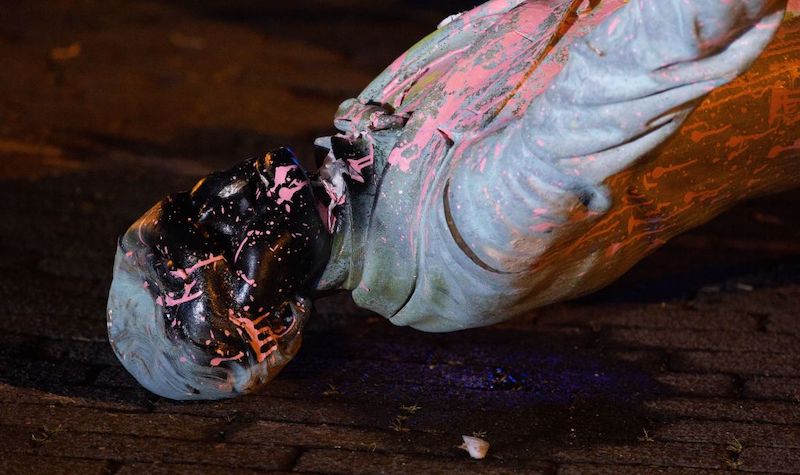
Historic preservation laws can hinder the removal of Confederate statues.
After hearing a proclamation of the newly adopted Declaration of Independence, a group of revolutionaries snuck into Bowling Green Park in Manhattan, threw ropes over a statue of King George III, and tore it from its pedestal. Two and a half centuries later, a group of protestors gathered on Monument Avenue in Richmond, Virginia, threw ropes over a statue of Confederate President Jefferson Davis, and brought it down to street level.
As public sentiment against Confederate monuments strengthens, local governments looking to remove statues are faced with a legal conundrum—historic preservation laws can make that task difficult.
A recent panel hosted by the University of Pennsylvania Cultural Heritage Center discussed the future of Richmond’s Confederate monuments following a summer of civil unrest and movements for racial justice. Until the protests in June, five monuments to Confederate leaders stood on Monument Avenue. Now, pending an appeal of recent court decision, only a monument to Robert E. Lee still stands.
More than 1,700 Confederate symbols, including 718 monuments, still remained in public spaces in 2018. Most symbols take the form of names of public schools, streets, and cities based on figures in the Confederate army. Statues, however, are a focus for activists and policymakers.
Much legal protection of Confederate statues stems from the state level. Richard C. Schragger and C. Alex Retzloff describe state-level laws as “statue statutes” that are created by legislatures to rein in recent attempts by progressive localities to remove Confederate symbols.
Jess R. Phelps and Jessica Owley explain that state historic preservation laws in the South are usually facially content-neutral, but there is no doubt that their real purpose is to protect Confederate monuments. Seven southern states have passed laws that fit that description, although Virginia recently amended their law to allow statue removal. Most of these laws were enacted in the last 20 years; three states enacted laws in just the last five years.
The Alabama Memorial Preservation Act, for example, was passed three years ago after the city of Birmingham, which is more than 70 percent Black, attempted to remove a Confederate monument. Because of penalties imposed under the Alabama Memorial Preservation Act, the city was ordered to pay a $25,000 fine for concealing the statue in 2017. The state attorney general promised to impose another fine if the statue were removed. Birmingham’s mayor ordered its removal in June of this year.
Federal laws, Phelps and Owley argue, are also major impediments because they mandate a costly and time-consuming consultation process to remove statues. Objects listed on the National Register of Historic Places receive protection from government interference and alteration. Over 100 symbols listed in the National Register database in 2019 include the word “Confederate” in the title.
J. Peter Byrne claims that Phelps and Owley overstate the difficulties that historic preservation laws pose to monument removal. Byrne resists characterizing state-level statutes as preservation laws at all because true preservation laws value historic expertise and exist to document historic context. Federal laws, Byrne argues, add substantial social value through the consultation process, which requires a removal proposal that considers research, community input, and alternative measures.
Byrne argues that these laws do not seriously impede removal efforts, but that preservation laws allow for a context in which differing, complicated views of heritage play out.
Advocates for preservation laws contend that Confederate monuments should not be removed because they express grief for fallen soldiers and honor the sacrifice of ancestors. If statues are dismantled, the country would lose an important educational tool about the Civil War and its effects, according to author Sophia A. Nelson.
Scholars who take the opposing view argue that the true purpose of Confederate monuments is not “to commemorate the dead but to subjugate the living”. Not only do people now view monuments as symbols of white supremacy, but they increasingly acknowledge that white supremacy was the aim of those who erected monuments. Phelps and Owley say that the meaning behind monuments is often complicated, but they also note that the implementation of Confederate symbols historically increases when Black people achieve greater equality.
Monument Avenue in Richmond was developed during an effort to push Black leadership from city government post-Reconstruction. Many monuments were not established until the late 19th century, well after the Civil War. One historian describes a “mail order” monument boom during that period in which statues were mass produced for private groups—these statues do not constitute carefully crafted works of art that now need special legal preservation.
Toppling Confederate monuments is a step to correct myths about how and why they were put there in the first place.
Going forward, one scholar proposes that monuments should be excepted from preservation laws when they celebrate human rights violations. Objectors state that removing statues is akin to neglecting history. In response, some historians propose photographing and cataloging Confederate symbols before removing them from public view.
The removal of cultural symbols of oppression can signal the rejection of values honored in the works. Statues solidify a point of view. The conscious decision to reject that cultural history indicates public desire to change the narrative. That is why King George no longer towers over Bowling Green Park and Jefferson Davis no longer casts a dark shadow over the city of Richmond.

